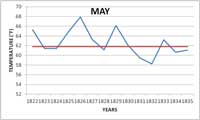CHAMPAIGN, Ill. - The oldest official weather records ever found in Illinois, dating back to 1820, reveal temperature data that showed remarkable accuracy given the technology of the day, according to State Climatologist Jim Angel of the Illinois State Water Survey (ISWS).
Angel and Lauren Graham, a recent graduate of the Department of Atmospheric Sciences at the University of Illinois at Urbana-Champaign, obtained original records from the 1820s and 1830s from the Rock Island Arsenal Museum. Records were hand written with ink and quill. They analyzed temperature readings taken three times daily at 7 a.m., 2 p.m., and 9 p.m. at what was then called Fort Armstrong on Rock Island from 1820 to 1836.
The temperature records appeared to be accurate, which was surprising given the high potential for error with primitive technology and different observing techniques, Angel said. For example, today we can record the high and low temperatures for each day as well as hourly temperature using electronic sensors. Back then they had to read glass thermometers located on a porch on the north side of a building.
“Compared to modern-day normal temperatures, the data were very reasonable,” he said. “When they’re in the same ballpark with today’s averages, you feel better about accuracy of the numbers.”
Although Angel and Graham didn’t see any temperatures that would break today’s records, they did find some interesting historical insights. For example, on February 8, 1831, the observer reported a temperature of -12 degrees at 7 a.m. and “30 inches of snow on the level,” which is likely a multi-day accumulation. Also, the records referred to a “violent hurricane” on July 21, 1820 in the first month of reports, which likely referred to either a tornado or severe thunderstorm with strong winds.
Other written comments on the weather records referenced ducks flying south, the condition of crops, and other events of everyday life.

See the data
“It was like reading someone’s diary,” Graham said. “We wondered about the differences in how they perceived weather events and if those perceptions were the same as they are today.”
Historical data of this type can be used to extend the record further back than what is used today. Unfortunately, a gap still remains between 1836 and the next oldest weather records at Peoria, which has continuous reports going back to 1856.
Angel occasionally receives calls from authors who are writing fiction or biographies who question the weather conditions on a particular day in history. It can be interesting to gain insights from day-to-day weather reports.
“These records give us a sense of a bigger picture of the weather in Illinois in the 19th century,” Angel said. Images of the original records can be found on the Water Survey website at https://stateclimatologist.web.illinois.edu/data/fort-armstrong-climate-records/.